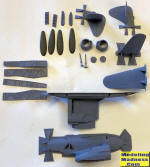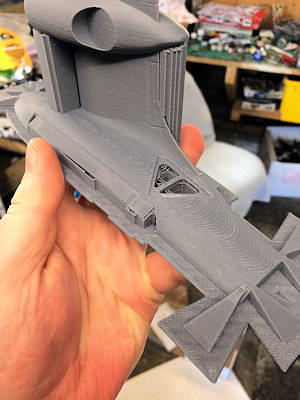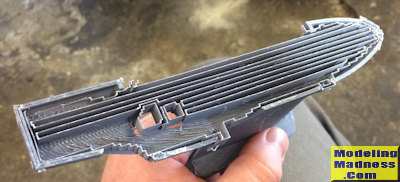
| KIT #: | |
| PRICE: | AUD$125.00 |
| DECALS: | None supplied |
| REVIEWER: | Zac Yates |
| NOTES: | 3D printed kit |

| HISTORY |
In early 1939, the Australian
Government ordered large numbers of Bristol Beaufort bombers, to be built in
railway workshops, and in doing so, by-passed the local aircraft company,
Commonwealth Aircraft Corporation.
CAC, under Sir Lawrence Wackett, began work on its own design, hoping to out-perform the Beaufort by building a machine that could serve as both a torpedo bomber and dive bomber. To keep down weight, Wackett dispensed with traditional self-sealing fuel tanks and opted to make the wing cavities liquid-tight, and thus serve as fuel storage. The Australian Government was initially uninterested in the CAC design. However, in mid-1940, cut off from the supply of British-made components for the Beaufort program (thanks to a British embargo on the export of aviation products, due to the need to maximise British production during the Battle of Britain), the Australian Government ordered a prototype of the CAC design, even before the Royal Australian Air Force had expressed a view about the machine. This prototype CA-4 took to the air on 19 September 1941. The CA-4 was a low wing, twin-engined, multi-role bomber with a crew of three. It was armed with four nose-mounted .303 calibre machine guns and two remote-controlled twin machine-gun barbettes mounted at the rear of the engine nacelles. It could carry either 500 lb (230 kg) bombs, 250 lb (110 kg) bombs or two torpedoes. It was originally powered by two Pratt & Whitney Twin Wasp R-1830-S3C3-G radials. Unfortunately, the novel fuel tanks never proved reliable, and in January 1943 the CA-4 prototype was completely destroyed in a mid-air explosion, probably due to a fuel leak.
With a re-designed tail and rudder, and an improved nose armament of two 20 mm cannon and two .303 calibre machine guns, the CA-4 became the CA-11 Woomera.
Faced with the crisis caused by the Japanese entry into the war in December 1941, the RAAF accepted the design even before testing was complete, and ordered 105 examples of the CAC bomber on 8 March 1942. However, after the loss of the first CA4 prototype, the redesigned CA-11 did not fly until June 1944. By the time production was due to commence, the dive-bombing concept had fallen into disfavour, the RAAF was filling the light bomber/reconnaissance/strike role with British-designed Bristol Beaufighters (which were being made in Australia by the Department of Aircraft Production); US-made B-24 Liberator heavy bombers had also become available. Consequently, the original Woomera order was reduced from 105 to 20. After the first CA11 flew, the whole program was cancelled and the production capacity set aside for Woomeras at CAC was switched to P-51 Mustang fighters. The only completed CA-11 Woomera, A23-1, was stripped for parts and scrapped in 1946. (lifted from Wikipedia)
Some parts of the two Woomeras remain in existence today, the largest of these being a restored turret from the CA-11 on display at the Australian National Aviation Museum at Moorabbin, Victoria.
| THE KIT |
 Perhaps typical for an “exotic” prototype
design not from one of the major powers of WW2, the modeller hasn’t been
well-served for his/her CAC Woomera needs. There have been a vacform and at
least one resin kit produced in 1/72 but these are long out of production,
scarce and fetch prices beyond their basic detail level when they are available.
There is a paper model available but otherwise nothing in 1/48.
Perhaps typical for an “exotic” prototype
design not from one of the major powers of WW2, the modeller hasn’t been
well-served for his/her CAC Woomera needs. There have been a vacform and at
least one resin kit produced in 1/72 but these are long out of production,
scarce and fetch prices beyond their basic detail level when they are available.
There is a paper model available but otherwise nothing in 1/48.
Enter Matt Gilks, an Australian modeller who collected ref erence
material from Hawker De Havilland (descendant company of CAC) with the aim of
producing a kit of the long-ignored Woomera using the newest tool of the
modeller: a 3D printer. Despite having full-time work obligations as well as
family commitments, Matt went from 3D CAD images to a completed prototype model
build in less than six months. The kit represents the CA-11, the later
redesigned version of the bomber first flown in June 1944.
erence
material from Hawker De Havilland (descendant company of CAC) with the aim of
producing a kit of the long-ignored Woomera using the newest tool of the
modeller: a 3D printer. Despite having full-time work obligations as well as
family commitments, Matt went from 3D CAD images to a completed prototype model
build in less than six months. The kit represents the CA-11, the later
redesigned version of the bomber first flown in June 1944.
Firstly it should be said that this is not a
project for the inexperienced or impatient: the bulk of this kit is made from
ABS plastic that was literally printed from a computer. Because of this moulding
technique a lot of parts preparation is needed, moreso than a comparable resin
kit. Not only are there triangul ar braces on the corners of some parts (similar
to resin pour plugs) but also “rafts”, thin sheets of plastic used as a backing
on hollow parts like the drop tank and fuselage halves. In addition there are
ridges all over the surface (think contour lines on a map) which will need to be
smoothed into shape. The parts count is a mere 22 for an aircraft not much
smaller than a Junkers 88 but there is a lot of work ahead. (pictures 03 and/or
04)
ar braces on the corners of some parts (similar
to resin pour plugs) but also “rafts”, thin sheets of plastic used as a backing
on hollow parts like the drop tank and fuselage halves. In addition there are
ridges all over the surface (think contour lines on a map) which will need to be
smoothed into shape. The parts count is a mere 22 for an aircraft not much
smaller than a Junkers 88 but there is a lot of work ahead. (pictures 03 and/or
04)
While the 3D printing process makes for a rough surface, it also means large structures can be moulded in place. Unlike the 1980s-vintage resin kits of the Woomera where one would need to butt-join the empennage and wings to the fuselage, the Woomera Models kit has each horizontal tail moulded to its respective rear fuselage half. Likewise the large centre-section wing on each side – complete with engine nacelle - is already moulded to the large fuselage sections. This will make for a very strong completed model. The plastic itself is quite hard and solid – the main landing gear legs are 3D printed but feel stronger than injection-moulded parts.
 The clear parts are vacforms on a single sheet.
One of each item – four in total - is provided and the canopy frames are not
present. They are very clear but thicker than a Falcon canopy. Control surfaces
are moulded in place with very well-defined, recessed hinge lines.
The clear parts are vacforms on a single sheet.
One of each item – four in total - is provided and the canopy frames are not
present. They are very clear but thicker than a Falcon canopy. Control surfaces
are moulded in place with very well-defined, recessed hinge lines.
The modeller will need to use their spares and the aftermarket for several components not included in the kit, chief among them the engines and wheels. A list of recommended items (such as “2 P-400 seats with Sutton harnesses”) is given on the box lid to help with this. No decals are included but the markings of the sole CA-11 were very simple: roundels in all six positions (Douglas A-20 decals are recommended), fin flashes, RAAF prototype logos and a serial make up the scheme. Thanks to the aftermarket and your spares, this shouldn’t be too big an ask. The aircraft also wore a paint job of all-over Foliage Green, however the exact shade is still a subject of debate so the choice of paint is left to the builder.
As the kit is aimed at the experienced modeller there are Building Notes rather than instructions, as well as very rare copies of manufacturer’s drawings and a cutaway drawing (to aid with building up the tube-based cockpits).
| CONCLUSIONS |
I’ve been a Woomera fan since I first saw a painting of one in a book about WW2 bombers. I was fortunate to find a vac kit on eBay last year but it was rough and a hard build which I rushed to finish once Matt announced this kit. I’m excited to build it. While it’s going to be a very involved build with some scrounging and extra expense for missing parts, I have no doubt it will produce a striking and very unusual model.
| REFERENCES |
References:
Wikipedia’s entry on the CA-4 and
CA-11:
https://en.wikipedia.org/wiki/CAC_Woomera
Development of the kit:
http://forum.aussiemodeller.com.au/viewtopic.php?f=2&t=10868&start=20#p87892
Matt Gilks’ prototype build:
http://www.aussiemodeller.com.au/forum/viewtopic.php?f=8&t=11372
Zac Yates
August 2016
Copyright ModelingMadness.com
Thanks to for the review kit. You can find this kit at your favorite hobby shop or on-line retailer
If you would like your product reviewed fairly and fairly quickly, please contact the editor or see other details in the Note to Contributors.